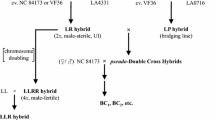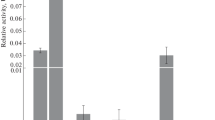Summary
We have previously described gene introgression from the wild nightshade Solanum lycopersicoides into tomato (Lycopersicon esculentum) through the use of either diploid or sesquidiploid hybrids (the latter consisting of two genomes of L. esculentum and one genome of S. lycopersicoides). Both types of intergeneric hybrids display pollen sterility, but workable ovule fertility. Unilateral incompatibility prevents their direct hybridization with staminate L. esculentum. Pollen of a self-compattible form of the related wild species L. pennellii is compatible with pistils of L. esculentum x S. lycopersicoides hybrids. This trait was backcrossed from L. pennellii to L. esculentum in order to develop bridging lines that could be used to obtain progeny from the intergeneric hybrids and to study the inheritance of bridging ability. In progeny of L. esculentum x S. lycopersicoides hybrids pollinated with L. pennellii-derived bridging lines, preferential transmission of L. pennellii alleles was observed for certain isozyme and RFLP markers on chromosomes 1, 6 and 10. The skewed segregations suggest linkage to three major pollen-expressed compatibility loci. This was confirmed by observations of pollen tube growth, which indicated that compatibility with pistils of the diploid intergeneric hybrid occurred only in bridging lines at least heterozygous for the L. pennellii markers on chromosomes 1, 6 and 10. Compatibility with the sesquidiploid hybrid required only the chromosome 1 and 6 loci, indicating an apparent effect of gene dosage on expression of incompatibility in the pistil. In an F2 L. esculentum x L. pennellii population, preferential transmission of L. pennellii alleles was observed for the same markers on chromosomes 1 and 10, as well as other markers on chromosomes 3, 11, and 12, but not 6. The chromosome 1 pollen compatibility locus maps to or near the S-locus, which determines S-allele specificity. The results are discussed in relation to existing genetic models for unilateral incompatibility, including the possible involvement of the S-locus.
Similar content being viewed by others
References
Anderson MA, Cornish EC, Mau SL, Williams EG, Hoggart R, Atkinson A, Bonig I, Grego B, Simpson R, Roche PJ, Haley JD, Penschow JD, Niall HD, Tregear GW, Coghlan JP, Crawford RJ, Clarke AE (1986) Cloning of cDNA for a stylar glycoprotein associated with expression of self-incompatibility in Nicotiana alata. Nature 321:38–44
Bernatzky R, Tanksley SD (1986) Genetics of actin-related sequences in tomato. Theor Appl Genet 72:314–321
Chetelat RT (1989) Isozyme gene linkage map of tomato (Lycopersicon esculentum). Isozyme Bull 22:19–23
Chetelat RT, Rick CM, DeVerna JW (1989) Isozyme analysis, chromosome pairing, and fertility of Lycopersicon esculentum x Solanum lycopersicoides diploid backcross hybrids. Genome 32:783–790
Cornish EC, Pettitt JM, Bonig I, Clarke AE (1987) Developmentally controlled expression of a gene associated with self-incompatibility in Nicotiana alata. Nature 326:99–102
deNettancourt D (1977) Incompatibility in angiosperms. Springer, Berlin Heidelberg New York
DeVerna JW, Chetelat RT, Rick CM, Stevens MA (1987) Introgression of Solanum lycopersicoides germplasm. In: Nevins D, Jones RA (eds) Tomato biotechnology. Alan R. Liss, New York, pp 27–36
DeVerna JW, Rick CM, Chetelat RT, Lanini BJ, Alpert KB (1990) Sexual hybridization of Lycopersicon esculentum and Solanum rickii by means of a sesquidiploid bridging hybrid. Proc Natl Acad Sci USA 87:9486–9490
Feinberg AP, Vogelstein B (1983) A technique for radiolabeling DNA restriction endonuclease fragments to high specific activity. Anal Biochem 132:6–13
Gadish I, Zamir D (1987) Differential zygotic abortion in an interspecific Lycopersicon cross. Genome 29:156–159
Gradziel TM, Robinson RW (1989) Solanum lycopersicoides gene introgression to tomato, Lycopersicon esculentum, through the systematic avoidance and suppression of breedng barriers. Sex Plant Reprod 2:43–52
Hardon JJ (1967) Unilateral incompatibility between Solanum pennellii and Lycopersicon esculentum. Genetics 57:795–808
Hogenboom NG (1972a) Breaking breeding barriers in Lycopersicon. 1. The genus Lycopersicon, its breeding barriers and the importance of breaking these barriers. Euphytica 21:221–227
Hogenboom NG (1972b) Breaking breeding barriers in Lycopersicon. 4. Breakdown of unilateral incompatibility between L. peruvianum (L.) Mill. and L. esculentum Mill. Euphytica 21:397–404
Hogenboom NG (1972c) Breaking breeding barriers in Lycopersicon. 5. The inheritance of the unilateral incompatibility between L. peruvianum (L.) Mill. and L. esculentum Mill. and the genetics of its breakdown. Euphytica 21:405–414
Hogenboom NG (1973) A model for incongruity in intimate partner relationships. Euphytica 22:219–233
Lewis D, Crowe LK (1958) Unilateral interspecific incompatibility in flowering plants. Heredity 12:233–256
Martin FW (1959) Staining and observing pollen tubes in the style by means of fluorescence. Stain Technol 34:125–128
Martin FW (1961) The inheritance of self-incompatibility in hybrids of Lycopersicon esculentum Mill. x L. chilense Dun. Genetics 46:1443–1454
Martin FW (1963) Distribution and interrelationship of incompatibility barriers in the Lycopersicon hirsutum Humb. and Bonpl. complex. Evolution 17:519–528
Martin FW (1964) The inheritance of unilateral incompatibility in Lycopersicon hirsutum. Genetics 50:459–469
Martin FW (1967) The genetic control of unilateral incompatibility between two tomato species. Genetics 56:391–398
Martin FW (1968) The behavior of Lycopersicon incompatibility alleles in an alien genetic milieu. Genetics 60:101–109
Mau SL, Williams EG, Atkinson A, Anderson MA, Cornish EC, Grego B, Simpson RJ, Kheyr-Pour A, Clarke AE (1986) Style proteins of a wild tomato (Lycopersicon peruvianum) associated with expression of self-incompatibility. Planta 169:184–191
McClure BA, Haring V, Ebert PR, Anderson MA, Simpson RJ, Sakiyama F, Clarke AE (1989) Style self-incompatibility gene products of Nicotiana alata are ribonucleases. Nature 342:955–957
McGuire DC, Rick CM (1954) Self-incompatibility in species of Lycopersicon Sect. Eriopersicon and hybrids with L. esculentum. Hilgardia 23:101–123
Mutschler MA (1990) Transfer of Lycopersicon pennellii cytoplasm into tomato (L. esculentum) does not create cytoplasmic male sterility. Rep Tomato Genet Coop 40:25–26
Poysa V (1990) The development of bridge lines for interspecific gene transfer between Lycopersicon esculentum and L. peruvianum. Theor Appl Genet 79:187–192
Quiros C, Ochoa O, Douches D (1986) L. peruvianum x L. pennellii sexual hybrids. Rep Tomato Genet Coop 36:31–32
Rick CM (1951) Hybrids between Lycopersicon esculentum Mill. and Solanum lycopersicoides Dun. Proc Natl Acad Sci USA 37:741–744
Rick CM (1963) Search for S locus. Rep Tomato Genet Coop 13:22–23
Rick CM (1982) Genetic relationships between self-incompatibility and floral traits in the tomato species. Biol Zentralbl 101:185–198
Rick CM (1986) Reproductive isolation in the Lycopersicon peruvianum complex. In: D'Arcy WG (ed) Solanaceae II. Biology and systematics. Columbia University Press, New York, pp 477–495
Rick CM, Chetelat RT (1991) The breakdown of self-incompatibility in Lycopersicon hirsutum. In: Hawkes JG, Lester RN, Nee M, Estrada N (eds) Solanaceae III. Taxonomy, chemistry and evolution (in press)
Rick CM, DeVerna JW, Chetelat RT, Stevens MA (1986) Meiosis in sesquidiploid hybrids of Lycopersicon esculentum and Solanum lycopersicoides. Proc Natl Acad Sci USA 83:3580–3583
Suiter KA, Wendel JF, Case JS (1983) LINKAGE-1: a Pascal computer program for the detection and analysis of genetic linkage. J Hered 74:203–204
Tanksley SD, Loaiza-Figueroa F (1985) Gametophytic self-incompatibility is controlled by a single major locus on chromosome 1 in Lycopersicon peruvianum. Proc Natl Acad Sci USA 82:5093–5096
Tanksley SD, Mutschler MA (1990) Linkage map of the tomato (Lycopersicon esculentum) (2N=24). In: O'Brien SJ (ed) Genetic maps, locus maps of complex genomes, 5th ed. Book 6, plants. Cold Spring Harbor Laboratory Press, Cold Spring Harbor, N.Y., pp 6.3–6.15
Taylor IB (1986) Biosystematics of tomato. In: Atherton JG, Rudich J (eds) The tomato crop: A scientific basis for improvement. Chapman and Hall, New York, pp 1–34
Young ND, Tanksley SD (1989) Restriction fragment length polymorphism maps and the concept of graphical genotypes. Theor Appl Genet 77:95–101
Author information
Authors and Affiliations
Additional information
Communicated by H. F. Linskens
Rights and permissions
About this article
Cite this article
Chetelat, R.T., DeVerna, J.W. Expression of unilateral incompatibility in pollen of Lycopersicon pennellii is determined by major loci on chromosomes 1, 6 and 10. Theoret. Appl. Genetics 82, 704–712 (1991). https://doi.org/10.1007/BF00227314
Received:
Accepted:
Issue Date:
DOI: https://doi.org/10.1007/BF00227314




